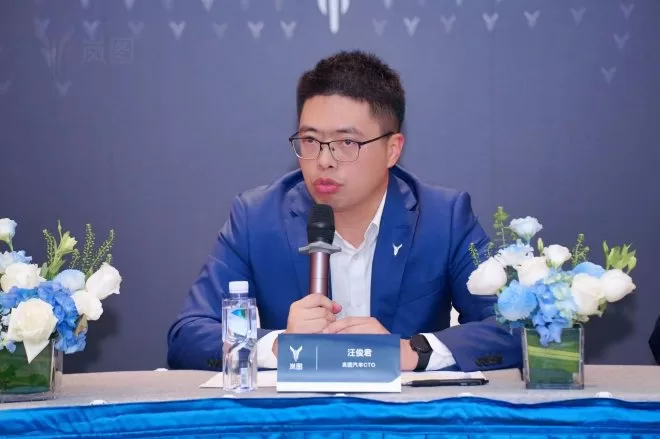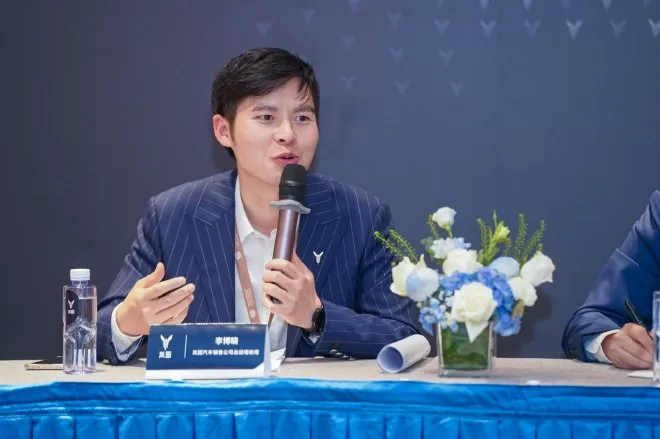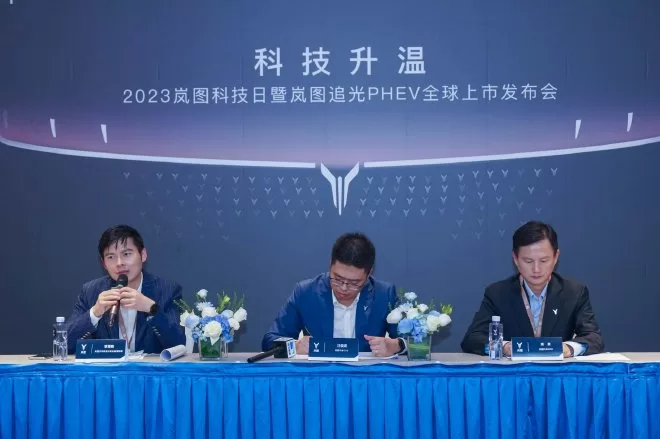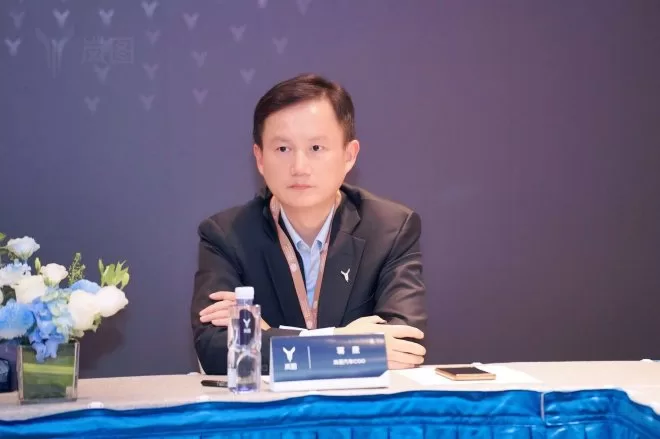On December 5th, the LanTu Chasing Light PHEV was officially launched. After the launch event, we had the honor of interviewing LanTu’s executives. The interviewees were LanTu CEO Wang Junjun, LanTu COO Jiang Tao, and LanTu’s Assistant General Manager of Sales, Li Boxiao. The focus of this media interview was on the newly released “Tianyuan Architecture” and the future market positioning and direction of LanTu. LanTu’s executives believe that the “Tianyuan Architecture” is based on the unity of the five domains and has a self-growing structure. This architecture allows for a personalized experience through the developer platform. It is this architecture that enables LanTu to have better competitiveness in both the extended range and PHEV fields, achieving simultaneous development in domestic and international markets and improvements in safety, intelligent driving, cabins, batteries, and overall vehicle quality. When asked about the advantages of LanTu Chasing Light PHEV over BBA, Wang Junjun stated that, compared to BBA, LanTu Chasing Light PHEV is a hybrid vehicle based on a pure electric platform, with a 262km electric range, which is currently the ceiling in this field, and a comprehensive range of 1260km. 1. The intelligent level of the car has obvious advantages, including the Tianyuan architecture released today, the Tianyuan architecture based on the integration of the five domains, L2.9-level intelligent driving, and high-speed point-to-point intelligent assisted driving, all of which are ahead of the BBA models. 2. The 3000mm wheelbase and 1970mm wide body have obvious advantages compared to BBA. 3. In the fields of intelligence, pure electric endurance, and safety, we have also done a lot of work. Therefore, from the above four areas, they are the core advantages and selling points of the Lantu Zhuiguang PHEV. Q: What is the current situation of the developer platform launched today, and what changes can it bring to future products? Wang Junjun: Lantu’s developer platform now has nearly 30 modules and more than 600 automotive interfaces. It has already cooperated with six major developers. The developers who have entered the platform include brain-computer interfaces, and IoT devices such as headphones/wristbands. I think the biggest advantage and benefit of the developer platform is that because we have the Tianyuan architecture, we have developed a self-growing architecture based on hardware and software. Developers can utilize the unlimited potential of the TSN architecture to truly deliver a “thousand people, a thousand faces” experience to customers.
Q: How does Lantu view the matter of high quality? Jiang Tao: Lantu is making high-end new energy vehicles, so quality is our bottom line, or you could say it’s the passing line. If it falls below this passing line, then we have crossed our lifeline. So we take quality very seriously. Currently, we divide quality into three levels: basic quality, exquisite quality, and brand-specific quality. 1. Basic quality: Currently, we use the evaluation standards of joint venture companies to measure the quality of Lantu’s cars. If our cars can meet the standards of joint venture companies, it means that the quality level of our cars has reached the level of joint venture companies. 2. Exquisite quality: We focus on details. As everyone knows, Lantu cars are priced at over 250,000 yuan (35040$), so with high prices, the quality must be raised. For example, the gap for Lantu Chasing Light can be achieved at 3mm-3.5mm. It’s very difficult to achieve this gap, and it involves many fields and technologies. But even so, we at Lantu strive for perfection. 3. Brand-specific quality: Basic quality ensures that the car has no shortcomings, while brand-specific quality has strengths. Lantu has put a lot of effort into the strengths. Currently, our cars have two strengths: easy to drive and safe. We have put a lot of effort into these areas. In general, we are a new brand, a user-oriented technology company, we adhere to long-termism, quality is our lifeline. We define 2024 as the year of quality, and we hope to do better in terms of quality. Q: Since June, Lantu’s sales have been rising, what are the key factors? Li Boxiao: I think Lantu has done a few things right. The first thing: we insist on being a high-end brand, and we have continued to increase investment in the brand. Everyone can see that during this time, we have actually established a basic label – “Lantu used by the country’s grand event”. This is not only offline activities, but also online operations. Whether it is from third-party data or our own user and market research visits, Lantu’s brand awareness and reputation have increased very rapidly this year. The second thing: in terms of product strength, for example, today’s launch of Lantu Chasing Light PHEV, it has a super strong product strength, which also represents Lantu’s will and strength. Whether it’s Chasing Light PHEV, or the new Lantu FREE, the new Lantu Dreamer, every car can compete well in the segmented market. This reflects our strong willingness to participate in the current market competition. We believe that behind this competition is also a competition of strength and efficiency.
Thirdly, we have insisted on user-oriented technology companies as the core. This year, we have done a lot of things with users to create, share, and build together. We now also have a user creation committee, which is very rare in China. We are pushing internal reforms and product improvements through this semi-official organization, including many suggestions from end users. We will continue to do this in the future. Fourthly, we are determined to cultivate and lay out in overseas markets, especially in developed countries in Europe. We have already entered Finland, Israel, Denmark, and Norway, and will soon be entering a series of other developed countries such as Bulgaria. We not only hope to sell cars there, but also to compete with BBA in developed country markets. Establishing a foothold there will also help build confidence in the domestic market for our LanTu brand. Q: What are the leading aspects of the Tianyuan architecture and what technological highlights can you share? Wang Junjun: From a hardware perspective, Tianyuan architecture is the first in China to integrate five domains into one. Although there are many companies in China working on multi-domain integration, LanTu’s integration is the most comprehensive. After integrating the cockpit, intelligent driving, vehicle body, power, and vehicle controller, the cost of the entire vehicle can be effectively reduced. By integrating all our hardware and software into the central end, we have laid the foundation for future OTA iterations. With the integrated Tianyuan architecture, OTA iteration speed can be increased threefold, and the entire vehicle wiring harness can be significantly reduced. In terms of software, we have transformed the traditional communication-based architecture into a service-based one, allowing new functions to be directly referenced in this way. This truly achieves the decoupling of software and hardware, and the Tianyuan architecture has the ability to self-grow, which are the two core advantages of the Tianyuan architecture. There are many highlights of the Tianyuan architecture in terms of chasing light. On one hand, this architecture gives various possibilities for the future. In terms of intelligent cockpit, the intelligent cockpit experience will be significantly improved, with significant improvements in both voice and HMI performance. On the other hand, Lantu’s chasing light has achieved the production and delivery of L2.9 level intelligent driving, and the intelligent driving system will continue to iterate and update based on the Tianyuan architecture. Q: How will the progress of NOA be implemented and what is the relationship with Apollo’s intelligent driving, and how will it be matched in the future? Wang Junjun: For Lantu itself, we have always been walking on two legs. One leg is to firmly do self-research, and the other leg is to cooperate with external partners. Lantu has now launched 3 models, FREE and Apollo have cooperated, while chasing light has done more independent development. Chasing light has now achieved L2.9 level intelligent driving assistance, and we are now working on NOA’s features. But we insist on two legs, our own capabilities in control, HMI; some underlying capabilities will cooperate with relevant ecosystem partners. Our internal goal now is to launch the first NOA function by the end of next year. At present, there is no exact information on the specific release time. Once we have it, we will communicate with everyone as soon as possible.
Q: Is the Orchid map currently rolling prices or focusing on value? Will the Orchid map focus on extended range or PHEV in the future? Li Boxiao: Without a doubt, the Orchid map will definitely roll value because price is only part of value in a sense. In addition to strong cost performance, we hope to bring users a full-scene, full-lifecycle user experience in the emotional value of the brand. This year, we have made great efforts in these areas. In the future, the Orchid map will still be positioned as a high-end brand, so we will not blindly lower the price, but we must ensure that each car is very competitive in the segmented market. We hope that each car we make can have a certain market share. Wang Junjun: I personally think that extended range and PHEV are just two technical solutions in different scenarios. It is difficult to say which one is good and which one is bad. What kind of choice the Orchid map will make depends mainly on user scenarios and user needs. The Orchid map will not exclude the extended range route in the future, and will also firmly promote the PHEV route, because the products that ultimately bring value to customers are truly good technical routes. Q: What are the advantages of the Orchid map compared to foreign high-end brands? Jiang Tao: First of all, it must be our core ability to make cars. Starting in 1984, the first joint venture was Beijing Jeep, and by 2023, nearly forty years have passed. We have trained a large number of technical talents in the joint venture automobile industry for nearly forty years, and have basically mastered the research and development, production, automobile equipment, and core component capabilities of automobiles. Therefore, we now have the ability to make a car, and we have the ability to make the car better than foreign luxury brands. In the second aspect, I think we understand Chinese people better than overseas luxury brands. Our iteration speed is faster. Their electric cars are basically just oil-to-electric conversions, and the perception of oil-to-electric conversions for customers is not particularly obvious. Maybe it’s just a little faster acceleration. Why have domestic luxury brands developed so fast in the past two years? In addition to platforms developed on the basis of pure electricity, Chinese cars also have smart cabins, intelligent driving, and air suspension. All of these things combined make the feeling of the car completely different from the past, with a qualitative change. This is our biggest advantage. We understand Chinese people. In the third aspect, iteration is particularly fast. In fact, “rolling” is a manifestation of fast iteration, constantly launching new products and new technologies. This continuous iteration of new things will better stimulate customer demand, and make us better and achieve a “thousand faces for a thousand people”. In the fourth aspect, we can achieve excellence in some areas. The original air suspension was a configuration of million-dollar luxury cars, and now we have made it a standard configuration for 300,000 cars. This is actually the result of our iteration and our technological accumulation and breakthroughs, which have led to this result. Q: How does Lantu understand safety and promote safety? Jiang Tao: Frankly speaking, our car has two selling points, it’s good to drive and it’s safe. It is implicit, unlike many new car companies, which have a lot of explicit things like big sofas and refrigerators inside. Our two selling points of being good to drive and safe are both implicit, but I think that every company has its own characteristics. We adhere to product-oriented marketing, slowly attracting customers, and letting them slowly accept our brand. Naturally, they will recommend our products to their friends and relatives, and this is how we will find our own market.
Wang Junjun: The redesigned EV version of Chasing Light has already used semi-solid-state batteries, which should be the first group in China to use semi-solid-state batteries. They are also developing solid-state batteries. They have a pilot line, and when the development is mature, they will use them together. Li Boxiao: Regarding sales volume and channels, I believe that everyone should have a very clear understanding of the product through today’s press conference. We are confident in successfully operating it. In terms of channels, it is mainly divided into two parts: domestic and overseas. Currently, we have a total of 285-290 stores in first, second, and third-tier cities in China, which can basically meet the needs of users in different scenarios. Next year, we will further expand our channel layout to better meet the convenience needs of users when using cars. In overseas markets, in addition to entering developed countries, the next clear destination is Germany, Italy, and France. Next year, there will be models launched overseas, including Dreamer, which has obtained European whole vehicle type approval. Dreamer should be the first domestic new energy MPV to obtain European whole vehicle type approval. Our efforts overseas are based on long-termism. We hope to represent the national team and change the world’s perception of Chinese manufacturing, including relatively economical images of Chinese cars. A: What are the goals and plans for intelligent cockpit, voice interaction, and HMI design? Wang Junjun: The impression that Lantu gives to users and the media is that the mechanical quality is very good, but there is a certain gap in intelligence compared to new forces. This is also the fundamental intention of General Lu’s release of the Tianyuan architecture today for all intelligent driving and cockpit. Its technical foundation is in electronic architecture. Without a good electronic architecture, it will be very difficult to build intelligent driving and cockpit on top of it. So the first thing we need to do is find a way to unify the electronic architecture of all models and truly achieve self-iteration and self-growth of this electronic architecture, and enable large models to truly empower the electronic architecture in the future. This is the first step. The second step, in terms of the cockpit, internally we firmly adopt the self-research route for HMI and ecology. We are also communicating with some mobile phone manufacturers, and there may be a relatively large release next year. We are still busy preparing for it. We hope to gradually build our own capabilities by polishing the architecture base, service base, HMI, voice, NLP, and DM of the cockpit, and improve the user experience in this way. In terms of intelligent driving, we are walking on two legs at the same time. On the one hand, we will try to deepen cooperation with ecological partners, including Baidu, and on the other hand, we will also strengthen our self-research capabilities. Next year, we will launch urban NOA function, and some ecological partners will empower us. Overall, we hope to continuously improve the capabilities of intelligent driving and cockpit, and improve the user experience on the basis of self-iteration, unified electronic architecture, and Tianyuan architecture.



